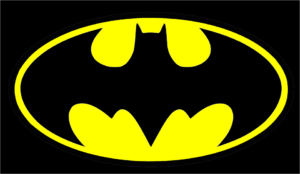
The live-action Batman television show that aired on ABC from 1966-1968 is revered by some and reviled by others. Why? Its distinctive campy humor and absurd style. If you’re a diehard fan of the show like me, this is your Batman. If you’re a Batman purist, this is your drunk uncle you’re nice to at Thanksgiving but try to avoid talking to if you see him in a public place. He’s part of the family, but he embarrasses you.
If you’re a diehard 60’s Batman fan, this blog post will affirm your good taste. If you’re a Batman purist, stick around for a little while. Maybe—just maybe—this blog will get you to reevaluate the old guy. Say hi to him at the grocery store. Help him decide which brand of garbanzo beans to try with those frozen tacos he likes to have on Tuesday night.
Because Batman is funny. Batman is campy. Batman is awesome. There are a lot of elements that go into Batman’s funny/campy/awesome style, but I believe you can basically break it down into these essential ingredients:
- Intelligent Writing
- Flashy Visuals
- Sharp Performances
Batman ’66 may have its lovers and its haters, but one thing we can all agree on is the consistency of its style. The show was a perfect storm of incredibly extreme stylistic choices. There are hundreds of people who work on any given TV show over the course of its run. The fact that so many people working on this show were all on the same loopy, candy-colored page is kind of a miracle. So let’s raise a Bat-glass to them and examine all these Bat-gredients in more depth.
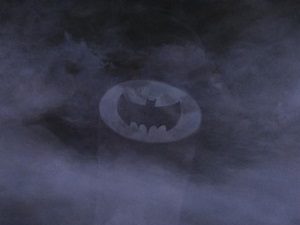
Intelligent Writing
As they say in the theater, if it ain’t on the page, it ain’t on the stage. And so it goes with Batman.
“But Batman was a TV show, not a play!” you say.
“You are correct,” I say. “However, Batman star Adam West has frequently referred to the show’s style of humor as ‘Theater of the Absurd.’ That’s a term coined by a theatre critic to describe a style of playwriting.”
“No way!” you exclaim. “Do tell.”
Well, since you insist. Theater of the Absurd specializes in the craziness of being alive, the weird things people do to make sense of their existence in a world devoid of apparent meaning. The “Absurd” is a concept introduced into our culture by Albert Camus, a fancy French philosopher. Pretty heady stuff for a comic book TV show, right?
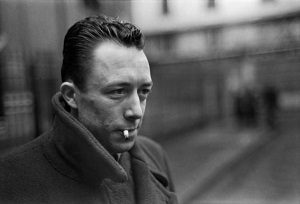
Right! This is what sets Batman apart from your average superhero. The only other major superhero TV show up to that point was just a straight-up serving of derring-do. The writers of Batman dared to make their hero an Absurd figure. Sure, he was a heroic crime fighter, but he was SUCH a do-gooder that he seemed hopelessly out of touch with the harshness of the modern world. Before he fires up the Batmobile to chase down the bad guys, he lectures Robin about wearing his seat belt. He corrects grammar in the middle of a fight. He’s the ultimate Boy Scout. Prepared for everything, even shark attacks.

These writers knew what they were doing. Instead of expecting us to accept a straightforward hero in the middle of the turbulent 60’s, they gave us satire. They showed us a guy who was just too good to be true. Someone clinging onto outdated modes of behavior. This show aired when an unpopular war dominated the headlines. People were protesting in the streets so that their government would treat them like citizens. This was not a time when establishment figures could be trusted to swoop in and fix everything. The writers were smart enough to realize this and give us the superhero we needed. Someone who wants rigid rules in a world full of chaos.
And what glorious chaos it is. Batman’s world is filled with delightfully absurd characters. Part of the writers’ genius was in pitting Batman against villains who are even more bizarre than he is. Their craziness makes Batman seem even more out-of-touch. He takes a logical step-by-step approach to catching criminals who do not use logic.
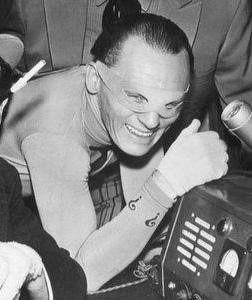
Take the Riddler, for instance. He’s one of the most nonsensical figures in the Batman canon. A criminal who’s constantly trying to get caught. When he commits a crime, he leaves a riddle behind that will lead Batman to his next crime. These riddles gave the writers some of their best opportunities to shine. As with many circumstances on this show, things work out way more easily than they should. The Riddler has a highly specific answer in mind for each of his riddles. Try and figure out this riddle—
“What weighs six ounces, sits in a tree, and is very dangerous?”
Have any answers in mind? I’m sure you could answer this in a variety of ways. But only one answer is right:
And somehow, Robin guesses that very answer. How did he know? How did it magically come to him? I’ll tell you how—absurdity. Unabashed weirdness. Wonderfully bizarre comic book dynamics.

Want to see the writers at work, really doing their research? Look no further than the King Tut episodes. King Tut is a mild-mannered Yale professor most of the time. But when he gets bumped on the head, he transforms into his alter ego. Which happens to be a supervillain who believes he’s the ancient Egyptian King Tut reincarnated. And this guy gets bumped on the head a lot. The writers have a field day with this guy. He becomes a repository for every last bit of pseudo-classical dialogue they have in their repertoires. Observe King Tut use the famous “Friends, Romans, Countrymen speech” from Shakespeare’s Julius Caesar while lowering Batman into boiling oil. Or how about his line when someone questions him—
“Who dares impugn the veracity of Tut—nabob of the Nile, moon god of Thoth, and stuff like that? By the instep of Ramses, I’ll have his head!”
Moon God of Thoth? Someone’s been doing their Egyptology research!
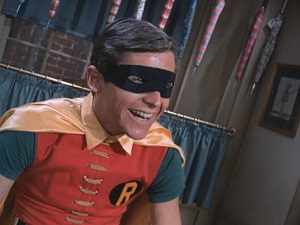
I could go on about the inventive dialogue. Robin’s habit of attaching “Holy” to a variety of words is well-known. There are a lot of gems in the list of “Holy” expressions used throughout the show. My personal favorite–
“Holy priceless collection of Etruscan snoods!”
Snood might not be a word you’ve heard before or will hear again, but now you know it thanks to Batman.
Flashy Visuals
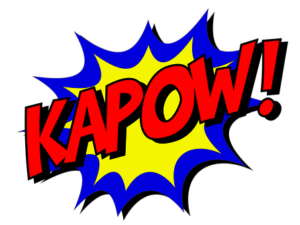
The writing provided the absurd foundation. The visual style took it the extra nine yards. Let’s start with what may be the most famous visual aspect of the show—the fight scenes. Nowadays, comic book movies and TV shows have intricate fight choreography designed to make audiences “oo” and “ahh.” Batman’s fight scenes feature some basic kicking and punching. So what makes them so special? The onomatopoeias.
“Onomato-what-a?” you say.
“Good one!” I respond. “Onomatopoeias are words used to describe sounds. Including sounds made from physical impact, such as ‘Bam’ or ‘Pow.’ Words that often accompany fight scenes in comic books.”
The onomatopoeias on this show made it clear that these characters live in a comic book. Whenever Batman and Robin fight anyone, words describing the impact of their blows cover the screen in bright colors. The words even change depending on the context of the fight. An underwater fight scene contains words like “BLOOP,” “GLURP,” and “SLOSH.” Fight scenes like this may not be as intense and gritty as fight scenes in other Batman media. They’re not supposed to! When watching a 60’s Batman fight scene, you’re not supposed to worry about physical danger. You’re supposed to laugh at the stylized absurdity of it all. This is a show that highlights the silliness of people in theatrical costumes beating each other up.
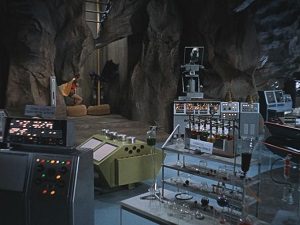
The absurdity doesn’t just stop at the fight scenes. Check out the Batcave! It’s full of gadgets and gizmos, all covered in absurdly specific labels. Did you know there’s a Twitter account devoted to pointing out this one visual quirk in the series? Follow it! You will not be sorry. Current Criminal Bat-Disclosure Unit, anyone? You gotta make sure the Entrance to Sub-Subterranean Grotto is clearly marked. Bat Research Shelf! Batweather Instruments! The list goes on and on. The Batworld is controlled with an obsessive amount of order and organization. Batman is a character fighting the randomness of a chaotic world with extremely specific labels like Dummy Lip Activator. The designers knew this and incorporated this insane amount of detail in every nook and cranny of the Batcave. It takes a lot of thought and care to create a world this stylized. Keep that in mind the next time you’re watching the show and scoff at the Interdigital Batsorter Anti-Crime Computer.
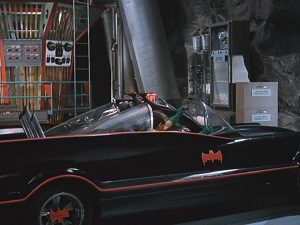
And how about that Batmobile? The absurdity of this vehicle is on full display, right from some of the first words spoken in the series:
“Atomic batteries to power. Turbines to speed.” “Roger, ready to move out.”
Who do you know who powers their car with an atomic battery? No one, and that’s the point. This car is the mechanical version of Batman, meaning it’s the Ultimate Boy Scout on wheels. Want to make a sudden turn? Parachutes come shooting out of the back to help you do a 180. There’s even a Batmobile Parachute Pickup Service Van to come get the parachutes after you’ve left them behind, so as not to litter. Chasing a bad guy’s van and want to slow it down? The Bat-Ray Projector will conk its ignition. So many modern superhero movies want you to believe that these superheroes could really exist. They spend a lot of time justifying how someone like Bruce Wayne would be able to amass such cool technology. Batman ’66 doesn’t care. Batman ’66 knows the technology is absurd. This show is about satirizing our ideals, not portraying life as it is.

How else could you have a Bat-Copter that’s shaped cartoonishly like a bat? Or a Batboat? Batcycle with a go-cart for Robin that disengages from the vehicle? There’s a Bat-everything to fulfill your crime-fighting needs by land, sea, or air. Because this is an absurd comic book world. We wish life was this easy.

In the real world, people don’t need costumes to fight crime or be criminals. But in Batman, it’s an absolute must. Batman NEEDS that cowl. Robin NEEDS those tights. There is no utilitarian purpose for this stuff. The costume isn’t body armor. It’s not even really designed to strike fear into the hearts of criminals. It’s just a uniform. Batman is a superhero. Superheroes need costumes. Batman wears a costume. No need to question the logic.

Why does the Joker wear that white makeup? Did he cut his skin and bleach it with chemicals? Not something that needs to be addressed on this show. Cesar Romero has a green wig and makeup because he’s the Joker. A person who just woke up one day, decided to dress like a clown, and commit clown-themed crimes. The fact that the actor’s well-known mustache is visible beneath the makeup only adds to the absurdity.
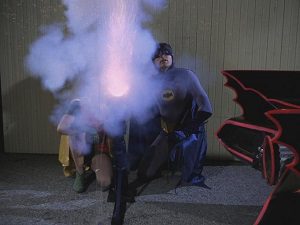
We don’t need to know why someone would want to wear a green leotard with a big question mark on it. Or a purple top hat and tuxedo. These are comic book characters, affirming their existence. Fighting meaninglessness with brightly colored knockout gas.
Writers may have dreamed up the absurd world of this show, but the over-the-top visuals take it to the next level. The crazy dialogue and oddball characterizations hinted at the masterpiece of specificity this show would become. The design team took it two-thirds of the way there. But there’s one piece missing to complete this hat trick of absurdity…
Sharp Performances
The scripts invented the crazy, the design elements gave the crazy someplace to live, but the actors themselves are the ones who truly brought the crazy home to roost. Television performances were relatively mannered in the 1950’s and 60’s. It’s rare that you see performances in this era as uninhibited and bizarre as you find in Batman. But the Theater of the Absurd concept set a lot of actors free. Let’s examine some more closely.

Adam West. The anchor of the show. He’s been described as being capable of “playing Alice in Wonderland as though he was acting Hamlet.” In the pilot episode, he enters a nightclub to scope out a lead. He’s dressed in full Batman costume. The maître d’ asks if he wants a ringside table, to which he replies, “Just looking, thanks, I’ll stand at the bar. I shouldn’t wish to attract attention.” Completely without irony. Adam West does this consistently throughout the series, playing absurd situations as if they were totally commonplace. He doesn’t hint that anything’s humorous, he simply plays the truth of the moment. Watch him have a serious conversation with a woman at the bar, then do a bizarre dance called the Batusi. He knows the whole thing is a joke but doesn’t play it as a joke. Which makes it all the funnier.
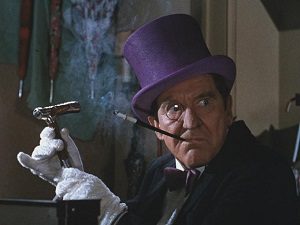
Burgess Meredith. The Penguin. The villain who made the most appearances on the show. So often, we think of villains as having evil superpowers. They might be aliens or robots. Burgess Meredith makes the Penguin a distinctive character through a laugh that sounds like a quack. And a waddle. The performers on this show didn’t need special effects to be outsized comic book figures. They did it through voice and physicality.
You can hear it in Frank Gorshin’s Riddler giggle. Or see it in the way Julie Newmar slinks down steps as Catwoman. These actors had a ton of fun playing over-the-top absurdity, and they are very fun to watch.
Bat-Conclusion
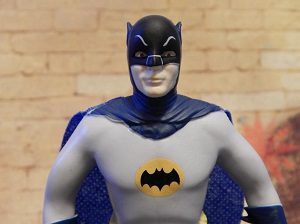
What else can I say? The absurdity of Batman ’66 lives on, whether anyone wants it to or not. The writing, the imagery, and the acting all work together to create a distinctly absurdist identity. It isn’t the “gritty” Batman of Snyder, Nolan, Burton, or the modern comics. It’s a Batman from an older world. An Absurd Batman fighting the darkness with a nonsensically out-of-touch do-gooder attitude. Maybe a drunk uncle we get embarrassed by from time to time, but one we can understand with the right perspective.